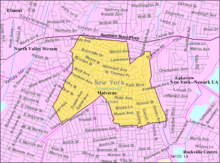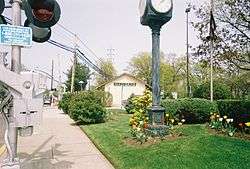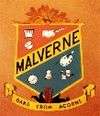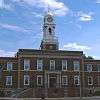Malverne, New York
| Malverne, New York | ||
|---|---|---|
| Village | ||
| Village of Malverne | ||
|
Malverne's main Long Island Rail Road station near the Village Hall. | ||
| ||
| Nickname(s): The Mayberry of Long Island | ||
| Motto: "Oaks From Acorns" | ||
 Location in Nassau County and the state of New York. | ||
 Location within the state of New York | ||
| Coordinates: 40°40′31″N 73°40′23″W / 40.67528°N 73.67306°WCoordinates: 40°40′31″N 73°40′23″W / 40.67528°N 73.67306°W | ||
| Country | United States | |
| State | New York | |
| County | Nassau | |
| Incorporated | April 20, 1921 | |
| Government | ||
| • Type | Village | |
| • Mayor | Patricia Ann Norris-McDonald | |
| • Village Clerk | Teresa Emmel | |
| Area | ||
| • Total | 1.0 sq mi (3 km2) | |
| • Land | 1.0 sq mi (3 km2) | |
| • Water | 0.0 sq mi (0 km2) | |
| Elevation | 36 ft (11 m) | |
| Population (2010) | ||
| • Total | 8,514 | |
| Time zone | Eastern (EST) (UTC-5) | |
| • Summer (DST) | EDT (UTC-4) | |
| ZIP code | 11565 | |
| Area code(s) | 516 | |
| FIPS code | 36-44787 | |
| GNIS feature ID | 0956328 | |
| Website |
www | |
Malverne is a village in the town of Hempstead in Nassau County, New York, United States. The population was 8,514 at the 2010 census.[1]
Geography

According to the United States Census Bureau, the village has a total area of 1.0 square mile (2.6 km2), all of it land.
History
Malverne was originally settled by the Rockaway Indians at an unknown point in history with the current Ocean Avenue serving as an Indian path. Western settlements can be dated back to the 1790s when the Cornwell family first settled and began farming the area.
Norwood, as it was originally known, formed a movement to become an incorporated village in the early 1920s. This area originally consisted of the communities of North Lynbrook and Malverne Park. It is widely believed that residents of the now Malverne Park area did not wish to become part of the new village and therefore requested not to be included. North Lynbrook was believed to be removed from the borders by then New York Lieutenant Governor Jeremiah Wood, who lived in that area at that time and did not wish to be in an incorporated village.
A vote was taken and voters decided to form an incorporated village by an overwhelming majority.
The spelling of the name was originally Malvern, minus the "e" as in the English connection. When the Long Island Rail Road started service to Malvern they spelled the name Malverne, with the "e". Although Malvern attempted to fix the error, the village changed the name to Malverne as so many people thought the name was spelled with the "e". This is a further indication how important rail service was to villages across the country and how powerful their effects were felt upon them.
The name was changed from Norwood to Malverne because a Village of Norwood already existed in upstate New York. The name Malverne originates from Malvern, England. Alfred Wagg, the main developers from the Amsterdam Development and Land Corporation, had visited Malvern and liked the name. The extra "e" was added to make it fancier.
Malverne's incorporation was finalized on April 13, 1921, however it had been acting as a village since October 1920. The village has celebrated the 1921 anniversary at the 25-year, 50-year, and 75-year.
Malverne was originally made up of many different communities (under one incorporated village). The communities were mostly made up of the original farmer of that area and those he sold his land to. While it is no longer viewed the same way, some of the neighborhood names can be found in the street names.
The village's growth has been credited to two major events – the selling of farm land for development and the Long Island Rail Road. The Amsterdam Development Corporation is responsible for the building of many of the homes in the village. Today, there are over 3000 homes in the village.
Today, many of its residents commute to New York City via the two Long Island Rail Road stations in the village – Malverne and Westwood, both located on the West Hempstead Branch. After a three-year hiatus, weekend train service was restored to the branch in November 2014.[2]
Government and politics
The village is governed by a Board of Trustees of which the Mayor sits as the chair. Each member of the board is elected to a four-year term of office. There is also a village judge that presides over violations of the village code. Elections are scheduled for the third Tuesday of March in odd numbered years.
The current elected officials are:
- Mayor Patricia McDonald
- Trustee John J. O'Brien
- Trustee Patricia M. Canzoneri-Callahan
- Trustee Keith M. Corbett
- Trustee Anthony L. Marino
- Judge James G. Frankie
The mayor appoints a deputy mayor to act in his/her absence. She/he also appoints liaisons and/or commissioners to each department in the village. The office of mayor was originally called president.
Malverne considered a "full service" municipality with nearly all government services provided by the village itself. The Village hosts its own Police Department, Volunteer Fire Department (Norwood Hook, Ladder & Hose Company), Volunteer Ambulance Corps, Police Reserve, Department of Public Works, Emergency Management Commission, Public Library, Youth Board, and village television station – MalverneTV.
Safety record
Recent studies have found that Malverne is considered to be one of the safest communities in both the state and country. A report based on 2012 statistics place the village the second-safest in New York, behind only Briarcliff Manor.[3][4]
Finances
In 2009, Standard & Poor's gave Malverne an AA+ credit bond rating, one of the highest ratings the financial institution gives out.[5]
Notable people
- Jason Michael Brescia - writer and director
- Gil Clancy[6] – legendary boxing trainer, commentator and International Boxing Hall of Famer
- Tony Danza – actor
- Fran Purcell – former Nassau County Executive[7]
- Ralph Flanagan – big-band leader
- Woody Gelman – publisher
- Jeffrey Goldberg – author and staff writer for The Atlantic Monthly
- Ray Heatherton - stage and TV personality (The Merry Mailman), father of Joey Heatherton
- Max Holden – magician
- Dan Ingram - radio DJ
- Stan MacGovern – comic strip cartoonist (Silly Milly)
- Steven McDonald - NYPD shooting victim, writer and speaker
- Ole Olsen - Olsen and Johnson comedy team
- Ralph Penza - television journalist
- Atoosa Rubenstein - magazine editor
- Rudy Rufer – New York Giants baseball shortstop
- Frank Scoblete – author
- Rick Shutter – drummer
- Frank Springer – cartoonist
- Charley Steiner – former ESPN sportscaster, current play-by-play voice for Los Angeles Dodgers
- Anthony Tommasini (born 1948) – music critic and author
Culture
Malverne was home to the original Brown Derby restaurant, which was a popular hang-out to many vaudevillians. This restaurant spawned the opening of the more famous Brown Derby in Los Angeles following the demise of Vaudeville.
The Lighting of Malverne, a holiday celebration and parade along Hempstead Avenue, is held annually on the first Saturday of December. It attracts thousands of people from Malverne and surrounding communities. The entire business district remains dark until the Mayor and the board flip a switch and all the holiday decorative lights are turned on. This kicks the start to a parade and many after
Demographics
| Historical population | |||
|---|---|---|---|
| Census | Pop. | %± | |
| 1930 | 2,256 | — | |
| 1940 | 5,153 | 128.4% | |
| 1950 | 8,086 | 56.9% | |
| 1960 | 9,988 | 23.5% | |
| 1970 | 10,036 | 0.5% | |
| 1980 | 9,262 | −7.7% | |
| 1990 | 9,054 | −2.2% | |
| 2000 | 8,934 | −1.3% | |
| 2010 | 8,514 | −4.7% | |
| Est. 2015 | 8,571 | [8] | 0.7% |
2010 census
As of the 2010 census the makeup of the village population was 88.4% White 83% Non-Hispanic White, 3.3% African American, 0.16% Native American, 4.2% Asian, 1.77% from other races, and 1.4% from two or more races. Hispanic or Latino of any race were 8.6% of the population.[10]
2000 census
As of the census[1] of 2000, there were 8,934 people, 3,106 households, and 2,534 families residing in the village. The population density was 8,499.1 people per square mile (3,285.2/km²). There were 3,152 housing units at an average density of 2,998.5 per square mile (1,159.0/km²). The racial makeup of the village was 92.04% White, 1.72% African American, 0.16% Native American, 3.10% Asian, 1.77% from other races, and 1.21% from two or more races. Hispanic or Latino of any race were 6.01% of the population.
There were 3,106 households out of which 34.1% had children under the age of 18 living with them, 70.2% were married couples living together, 8.5% had a female householder with no husband present, and 18.4% were non-families. 15.2% of all households were made up of individuals and 8.8% had someone living alone who was 65 years of age or older. The average household size was 2.87 and the average family size was 3.21.
In the village the population was spread out with 23.1% under the age of 18, 6.5% from 18 to 24, 26.9% from 25 to 44, 27.8% from 45 to 64, and 15.6% who were 65 years of age or older. The median age was 41 years. For every 100 females there were 93.5 males. For every 100 females age 18 and over, there were 88.5 males.
The median income for a household in the village was $81,784, and the median income for a family was $87,197. Males had a median income of $53,077 versus $37,743 for females. The per capita income for the village was $31,418. About 1.0% of families and 1.6% of the population were below the poverty line, including 0.7% of those under age 18 and 3.5% of those age 65 or over.
References
- 1 2 "American FactFinder". United States Census Bureau. Retrieved 2008-01-31.
- ↑ http://www.fios1news.com/longisland/node/77011
- ↑ http://www.safechoicesecurity.com/blog/safest-cities-new-york/
- ↑ http://www.newsday.com/long-island/towns/malverne-named-one-of-new-york-state-s-safest-cities-1.6819621
- ↑ http://liherald.com/stories/Malverne-gets-an-AA+,20697
- ↑ http://malverne-westhempstead.patch.com/articles/malverne-mourns-death-of-boxing-legend-gil-clancy
- ↑ http://www.newsday.com/long-island/nassau/francis-purcell-former-nassau-county-executive-dead-at-95-1.8060217
- ↑ "Annual Estimates of the Resident Population for Incorporated Places: April 1, 2010 to July 1, 2015". Retrieved July 2, 2016.
- ↑ "Census of Population and Housing". Census.gov. Retrieved June 4, 2015.
- ↑ http://quickfacts.census.gov/qfd/states/36/3644787.html
External links
| Wikimedia Commons has media related to Malverne, New York. |
| Wikivoyage has a travel guide for Malverne. |
- Inc. Village of Malverne – official web site
- Malverne Union Free School District
- Malverne Police Department
- Malverne Fire Department
- Our Lady of Lourdes Roman Catholic Church
- Malverne Jewish Center
- Malverne Police Reserve
- Malverne Public Library
- Malverne Volunteer Ambulance Corps
- Malverne Little League


